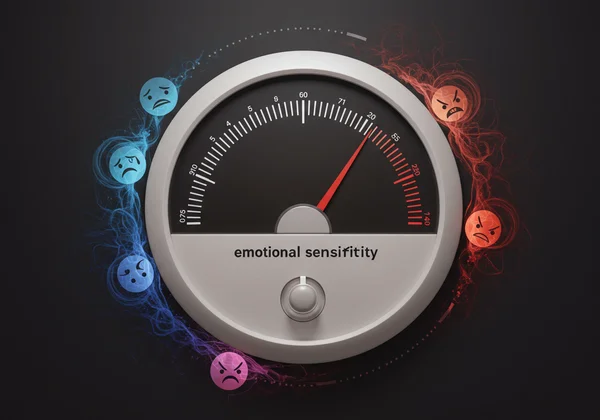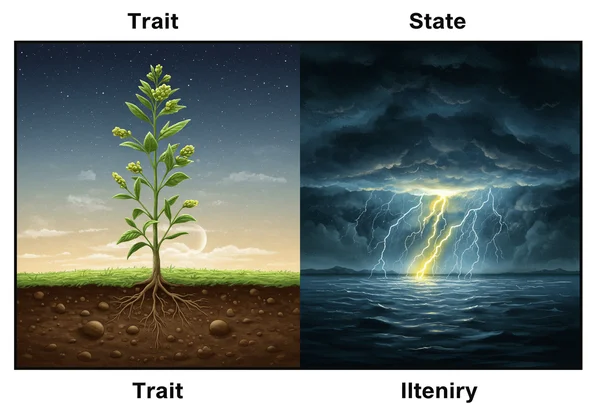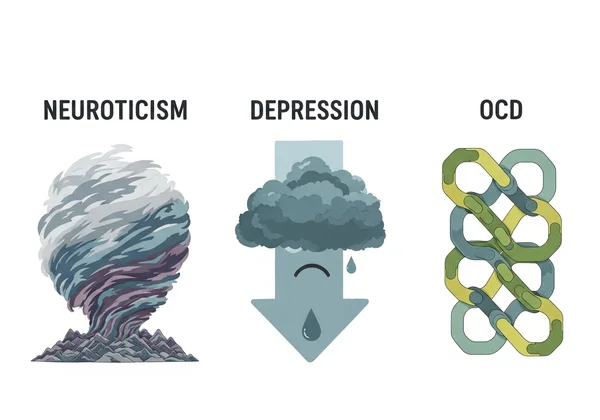Neuroticism Test vs. Anxiety, Depression & OCD: Know the Difference
It's easy to feel overwhelmed by emotions or constant worry, especially when terms like neuroticism, anxiety, depression, or OCD seem to overlap. Many people struggle to pinpoint what they're truly experiencing. Am I neurotic or just anxious? This is a question many people ask. This guide clarifies the crucial differences, empowering you to better understand your emotional landscape.
Understanding your emotional tendencies is the first step toward personal growth. A great way to begin this exploration is by learning where you fall on the neuroticism spectrum. For a clear, science-backed starting point, consider taking an online neuroticism test to gain personal insight.
Understanding Neuroticism: More Than Just Worry
First, let's define neuroticism. Neuroticism is not a flaw or a disorder; it is one of the "Big Five" personality traits that psychologists use to map the human personality. It represents a long-term tendency to experience negative emotional states like sadness, anger, guilt, and anxiety. Think of it as an emotional thermostat—some people's are just naturally set to be more sensitive to threats, frustrations, and losses.

This heightened sensitivity isn't inherently bad. It can make individuals more conscientious, prepared, and aware of potential risks. However, without effective coping strategies, it can also lead to chronic stress and worry.
What Are the Big Five Traits of Neuroticism?
Neuroticism is a broad domain, but it's often characterized by several key facets. These are not separate boxes but interconnected emotional patterns that contribute to the overall trait. Individuals high in neuroticism often display:
- Anxiety: A tendency to worry about potential future events and feel tense or fearful.
- Angry Hostility: A proneness to experience anger and frustration, especially when things don't go as planned.
- Depression: A tendency toward feelings of sadness, guilt, and hopelessness, though this is different from clinical depression.
- Self-Consciousness: A heightened sensitivity to what others think, often leading to shyness or social anxiety.
- Impulsiveness: Difficulty resisting urges or cravings, which can manifest in behaviors like overeating or excessive spending.
- Vulnerability to Stress: A lower tolerance for stress, feeling easily overwhelmed by challenging situations.
Common Emotional Patterns and Behaviors
How does a person with high neuroticism typically behave? They might be the friend who overthinks a simple text message, worries for days about an upcoming presentation, or takes constructive criticism very personally. Their emotional reactions to events may seem disproportionate to others.
These behaviors stem from a tendency to interpret ordinary situations as threatening and minor frustrations as hopelessly difficult. This isn't a conscious choice but a deeply ingrained pattern of emotional response. Understanding this pattern is key to managing it. To see how these traits might relate to you, an emotional stability test can provide a helpful perspective.
Neuroticism vs. Anxiety: Unpacking the Overlap
This is perhaps the most common point of confusion. Anxiety is a core component of neuroticism, but the two are not interchangeable. Distinguishing between them is crucial for finding the right path forward, whether that's self-improvement or seeking professional help.
Is Neuroticism Just Anxiety? Understanding the Core Distinction
The simplest way to understand the difference is to think of "trait vs. state." Neuroticism is a personality trait—a stable, long-term part of your personality that predisposes you to feel anxious. A clinical anxiety disorder, like Generalized Anxiety Disorder (GAD), is a diagnosable state or condition.

Neuroticism is the fertile ground where anxiety might grow, but it is not the anxiety plant itself. A person can be high in neuroticism and learn coping mechanisms to manage their anxiety effectively, never developing a clinical disorder. Conversely, while less common, someone lower in neuroticism could develop an anxiety disorder due to extreme trauma or stress.
General Anxiety Disorder (GAD) and Neurotic Traits Compared
Let's break down the comparison. High neuroticism means you are prone to worry. GAD, on the other hand, is characterized by excessive, uncontrollable worry about multiple things that is persistent (lasting at least six months) and significantly impairs your daily life.
| Feature | High Neuroticism (Personality Trait) | Generalized Anxiety Disorder (Clinical Condition) |
|---|---|---|
| Nature | A stable predisposition to negative emotions. | A specific, diagnosable mental health condition. |
| Worry | Frequent worry, but it may not be constant or debilitating. | Excessive, persistent, and uncontrollable worry. |
| Impact | May cause internal distress but doesn't necessarily impair functioning. | Causes significant distress and impairs social or occupational life. |
| Scope | A broad tendency affecting various emotional responses. | Focused on specific diagnostic criteria defined in the DSM-5. |
| Treatment | Managed through self-awareness, coping skills, and lifestyle changes. | Often requires professional therapy (like CBT) and/or medication. |
If you're curious about your predisposition, you can start your assessment for a better understanding of your personal traits.
Differentiating Neuroticism from Depression and OCD
Like anxiety, neuroticism's negative emotional patterns can sometimes resemble symptoms of depression and Obsessive-Compulsive Disorder (OCD). However, the underlying mechanisms and definitions are distinct.

When Neuroticism's Tendencies Mirror Depressive Symptoms
A person high in neuroticism is more prone to feelings of sadness, discouragement, and guilt. This is the "depressive" facet of the trait. However, this is different from Major Depressive Disorder (MDD).
MDD is a mood disorder characterized by a persistent low mood, loss of interest or pleasure in activities (anhedonia), changes in sleep or appetite, and low energy. It's often episodic. Neuroticism, by contrast, is a consistent personality pattern. While high neuroticism is a significant risk factor for developing depression, many people with high neuroticism never experience a clinical depressive episode. The key difference is the severity, persistence, and functional impairment seen in MDD.
Obsessive-Compulsive Disorder (OCD) and Neurotic Tendencies
The tendency to ruminate and overthink, common in neuroticism, can sometimes be mistaken for the obsessions seen in OCD. However, they are fundamentally different.
In neuroticism, worries are typically about real-life concerns—work, relationships, health—even if the level of worry is exaggerated. In OCD, obsessions are intrusive, unwanted, and often irrational thoughts, images, or urges that cause intense distress. These obsessions are followed by compulsions, which are repetitive behaviors or mental acts performed to neutralize the anxiety (e.g., excessive hand-washing, checking, counting). This obsession-compulsion cycle is the hallmark of OCD and is not a feature of neuroticism itself.
Why These Distinctions Matter for Your Self-Understanding
Making these distinctions isn't just an academic exercise. It has real-world implications for how you view yourself and what steps you take to improve your well-being.
The Crucial Role of a Personality Trait Versus a Clinical Diagnosis
Understanding neuroticism as a personality trait is empowering. It's a part of your wiring, not a sign that you are broken. You can learn to work with your tendencies, harnessing the conscientiousness that often comes with it while developing skills to regulate your emotional responses. A personality test can be a fantastic tool for this kind of self-exploration.
A clinical diagnosis, on the other hand, identifies a condition that is causing significant impairment and typically requires professional treatment. Labeling a personality trait as a disorder can be stigmatizing and unhelpful, while ignoring a true disorder can prevent someone from getting the help they need. If you want to explore your traits, take a free test today.
When and Why to Seek Professional Mental Health Guidance
Self-assessment tools are excellent for increasing self-awareness. However, they are not a substitute for professional diagnosis. If your symptoms of anxiety, low mood, or obsessive thoughts are severe, persistent, and interfering with your ability to work, study, or maintain relationships, it is essential to consult a doctor, psychologist, or licensed therapist.

Disclaimer: The information and tools on this website are for educational and self-assessment purposes only. They are not intended to be a substitute for professional medical advice, diagnosis, or treatment.
Your Path to Clarity and Empowered Self-Assessment
Distinguishing between neuroticism, anxiety, depression, and OCD is a crucial step toward emotional clarity. Neuroticism is the personality trait that shapes your emotional climate, while anxiety, depression, and OCD are specific storms that may require professional help to navigate.
Knowing your inherent tendencies gives you the power to build stronger emotional foundations. It allows you to develop tailored coping strategies, communicate your needs more effectively, and approach your emotional life with compassion and understanding.
Ready to take the first step? Discover more about your unique personality profile by taking our free, science-based neuroticism test.
Frequently Asked Questions About Neuroticism and Mental Health
Am I neurotic or just anxious?
Neuroticism is a long-term personality trait that makes you more prone to experiencing negative emotions, including anxiety. An anxiety disorder is a clinical condition where anxiety is excessive, persistent, and impairs your daily life. You can be high in neuroticism without having an anxiety disorder.
What are the Big 5 traits of neuroticism?
The core facets, or traits, of neuroticism within the Big Five model are typically anxiety, angry hostility, depression (as a tendency toward low mood), self-consciousness, impulsiveness, and vulnerability to stress.
How does a neurotic person typically behave?
A person high in neuroticism may tend to overthink situations, react more strongly to stressors, worry frequently about the future, and experience more mood swings. They may also be more self-critical and sensitive to criticism from others. Learning about these patterns is the first step, and a personality test can help.
What does a high neuroticism score mean in general?
A high neuroticism score suggests you have a stronger-than-average tendency to experience negative emotions like worry, sadness, and irritability. It doesn't mean you have a disorder, but it does indicate that you might benefit from developing robust coping skills for managing stress and regulating your emotions.